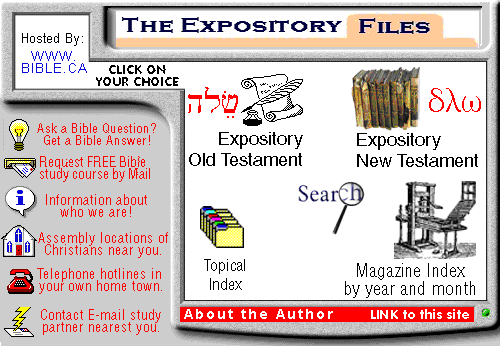
Take Heed How You See
1 Timothy 4:13
Most of us are familiar with the words of Jesus in Luke 8:18, "take heed
therefore how ye hear" (KJV). We also ought to take heed how we see. Generally
speaking, our eyes play an important role in our faith because the Bible is a
book to be read, reread, studied, analyzed and then read again, ad infinitum.
1 Timothy 4:13 says, "Until I come, devote yourself to the public reading of
Scripture." Paul expresses his personal need for reading and study when he
requests of Timothy, "When you come, bring . . my scrolls, especially the
parchments" (2 Tim 4:13). Our physical eyes, therefore, play in important role
in the process of establishing faith and in our unending effort to remain
strong in that faith.
There are differences, however, in how one sees the scriptures. One can see a
scripture simply in the act of viewing it. It can also be said that one sees
the scriptures in looking closely at its details. And finally, one can see a
passage in the sense that he perceives its spiritual meaning and application.
The differences between viewing, looking closely, and perceiving are
remarkably illustrated in the empty tomb narrative of John 20:1-10. In this
context the English word see (or a slight variation) is used to translate
three different Greek words, which when examined, reveal three different ways
of seeing.
Viewing
Upon receiving Mary Magdalene's report that Jesus' body had been taken out of
the sepulcher, Peter and John run together to the place of burial. "Both were
running, but the other disciple outran Peter and reached the tomb first. He
bent over and looked in at the strips of linen lying there but did not go
in"(Jn 20:4,5). The Greek word translated looked is blepei. The meaning of the
word indicates that Peter simply viewed or took a look at the contents of the
tomb from without, apparently without any significant reaction other than the
affirmation that what Mary had just seen and reported was true.
Looking Closely
Peter's observation was more intimate. The context says: "Then Simon Peter,
who as behind him, arrived and went into the tomb. He saw the strips of linen
lying there, as well as the burial cloth that had been around Jesus' head. The
cloth was folded up by itself, separate from the linen" (Jn 20:6,7). Peter
actually went into the sepulcher and saw something clearly astounding. The
napkin, or head roll, was still intact like a cocoon, all rolled up. The Greek
word translated see in this instance is theorei. The meaning is to behold, or
to look closely or intently. Peter stood there looking and looking at those
bands of linen and the head roll. He did more than just view or glance over
the items in the tomb. He knew he was looking at something special, unusual
and significant. Peter's seeing was more intense than John's for Peter was
face to face with the impossible: the separation of a body from its grave
wrappings, without the disturbance of the latter.
Perceiving
The text continues with John entering the tomb. "Finally, the other disciple,
who had reached the tomb first, also went inside. He saw and believed" 20:8).
The text says that John saw. The Greek word here is eiden. The meaning here is
to perceive or understand. John saw and believed. He believed as a consequence
of what he saw. In this context the word must mean that he believed in the
resurrection of Jesus. The evidence before his eyes he read rightly and
reacted in the right way. In the previous instance, when Peter saw the
contents of the tomb, even though he looked closely at the evidence, he did
not believe. As a matter of fact Luke 24:12 tells us that Peter went away
confused, wondering to himself what had happened. However, when John saw the
evidence that Peter saw, he was convinced. He believed.
Conclusion
How do you see the Scriptures? What is your reaction when you consider the
evidence for the resurrection of Jesus? You say that you do believe in Jesus
and in the fact of his resurrection! Well, then how do you see the commands of
Jesus? Is it your habit to simply view the Bible as a good book filled with
good suggestions? Or have you gone a step farther and looked closely at the
Word of God to see how it applies to your life? Hopefully, you will see and
believe as John did.
By Ed Barnes
From Expository Files 12.1, January 2005

https://www.bible.ca/

